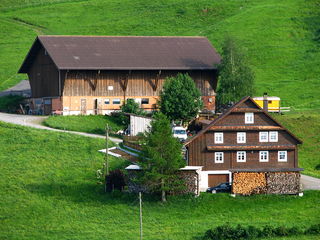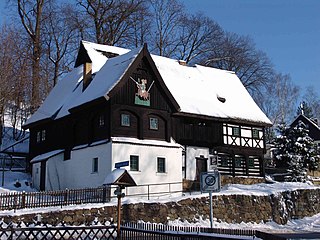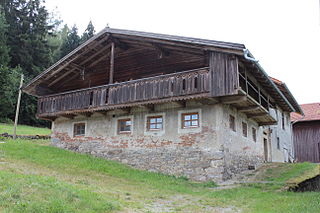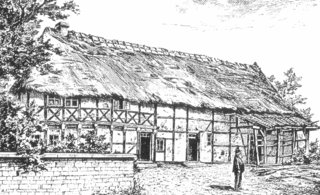Construction
The Middle German house is a byre-dwelling (Wohnstallhaus) with entrances to the various rooms down one side. The front door is thus at the side of the building and opens into the Ern, a Franconian expression for the central hallway or Flur, and cooking area.
The house is divided into three zones:
- Living quarters (Stube)
- Hallway (Flur or Ern) (with the stove or kitchen)
- Working area – stalls or stables (Stall)
The Ern is the central area of the house and has a stove area (later a kitchen) at the back This developed from the ancient hearth near the main entrance or between the doors if the house had a "crosspassage". On one side of the Flur there is a doorway to the living area and on the other to the working area. From the outset the house had two fireplaces. In the living room, the Stube, there was a cocklestove, and in the Flur was a stove for cooking, which was later partitioned off to form a kitchen.
Initially, this type of house only had one storey, but from about the 15th century they were usually built in two storeys with a ground floor and upper floor. From the 17th century the upper storey was built as a jetty and had artistic features such as beam heads (Balkenköpfe) and wall plates (Schwellen). In this period, the larger farms were built with several buildings that served as the living accommodation, barn and stable or byre of a two-, three- or four-sided farmyard.

A kitchen is a room or part of a room used for cooking and food preparation in a dwelling or in a commercial establishment. A modern middle-class residential kitchen is typically equipped with a stove, a sink with hot and cold running water, a refrigerator, and worktops and kitchen cabinets arranged according to a modular design. Many households have a microwave oven, a dishwasher, and other electric appliances. The main functions of a kitchen are to store, prepare and cook food. The room or area may also be used for dining, entertaining and laundry. The design and construction of kitchens is a huge market all over the world.

A barn is an agricultural building usually on farms and used for various purposes. In North America, a barn refers to structures that house livestock, including cattle and horses, as well as equipment and fodder, and often grain. As a result, the term barn is often qualified e.g. tobacco barn, dairy barn, cow house, sheep barn, potato barn. In the British Isles, the term barn is restricted mainly to storage structures for unthreshed cereals and fodder, the terms byre or shippon being applied to cow shelters, whereas horses are kept in buildings known as stables. In mainland Europe, however, barns were often part of integrated structures known as byre-dwellings. In addition, barns may be used for equipment storage, as a covered workplace, and for activities such as threshing.
The Japanese kitchen is the place where food is prepared in a Japanese house. Until the Meiji era, a kitchen was also called kamado and there are many sayings in the Japanese language that involve kamado as it was considered the symbol of a house. The term could even be used to mean "family" or "household". Separating a family was called kamado wo wakeru, or "divide the stove". Kamado wo yaburu means that the family was broken.

A farmhouse is a building that serves as the primary quarters in a rural or agricultural setting. Historically, farmhouses were often combined with space for animals called a housebarn. Other farmhouses may be connected to one or more barns, built to form a courtyard, or with each farm building separate from each other.

Multifamily residential is a classification of housing where multiple separate housing units for residential inhabitants are contained within one building or several buildings within one complex. Units can be next to each other, or stacked on top of each other. A common form is an apartment building. Many intentional communities incorporate multifamily residences, such as in cohousing projects. Sometimes units in a multifamily residential building are condominiums, where typically the units are owned individually rather than leased from a single apartment building owner.

A farmhouse kitchen is an architectural term for a kitchen room designed for food preparation, dining and a sociable space. Typical of poorer farmhouses throughout the Middle Ages where rooms were limited, wealthier households would separate the smoke of the kitchen from the dining and entertaining areas. Farmhouse kitchens were also known as smoke kitchens before Extractor hoods. Extractor hoods and modern stoves have allowed the reintroduction of farmhouse kitchen to architecture it is now the most popular kitchen design with various island set ups used for dining and storage. Household kitchen design often assumes that the functionality of the room includes cooking, dining and socializing but the term 'kitchen' includes rooms dedicated to cooking.

The Low German house or Fachhallenhaus is a type of timber-framed farmhouse found in northern Germany and the easternmost Netherlands, which combines living quarters, byre and barn under one roof. It is built as a large hall with bays on the sides for livestock and storage and with the living accommodation at one end.

A Gulf house, also called a Gulf farmhouse (Gulfhof) or East Frisian house (Ostfriesenhaus), is a type of byre-dwelling that emerged in the 16th and 17th centuries in North Germany. It is timber-framed and built using post-and-beam construction. Initially Gulf houses appeared in the marshes, but later spread to the Frisian geest. They were distributed across the North Sea coastal regions from West Flanders through the Netherlands, East Frisia and Oldenburg as far as Schleswig-Holstein. This spread was interrupted by the Elbe-Weser Triangle which developed a type of Low German house instead, better known as the Low Saxon house.

A housebarn is a building that is a combination of a house and a barn under the same roof. Most types of housebarn also have room for livestock quarters. If the living quarters are only combined whith a byre, whereas the cereals are stored outside the main building, the house is called a byre-dwelling.
The Geestharden house, also called the Cimbrian house, Schleswig house, Slesvig house or Southern Jutland house due to its geographical spread in Jutland, is one of three basic forms on which the many farmhouse types in the north German state of Schleswig-Holstein are based. The other two basic designs are the Gulf house and the Low German hall house. By far the best known variant of the Geestharden house is the Uthland-Frisian house, which is also referred to as the Frisian house (Friesenhaus).

The Uthland-Frisian house, a variation of the Geestharden house, is a type of farmhouse that, for centuries, dominated the North Frisian Uthlande, that is the North Frisian Islands, the Halligen and the marshlands of northwest Germany.

The Upper Lusatian house or Umgebindehaus is a special type of house that combines log house, timber-framing and building stone methods of construction. It is especially common in the region running from Silesia through Upper Lusatia and North Bohemia and into Saxon Switzerland, as well as East Thuringia.

A byre-dwelling is a farmhouse in which the living quarters are combined with the livestock and/or grain barn under the same roof. In the latter case, the building is mostly called an housebarn.

Tyneside flats are a form of UK domestic housing found primarily on Tyneside, including in Newcastle upon Tyne, Gateshead, South Tyneside and North Tyneside. The first known example of this type was constructed in the 1860s.

The Black Forest house is a byre-dwelling that is found mainly in the central and southern parts of the Black Forest in southwestern Germany. It is characterised externally by a long hipped or half-hipped roof that descends to the height of the ground floor. This type of dwelling is suited to the conditions of the Black Forest: hillside locations, broad tracks, high levels of snowfall and heavy wind loading. Individual farms, such as the Hierahof near Kappel, which are still worked today, are over 400 years old. The Black Forest house is described by Dickinson as very characteristic of the Swabian farmstead type.

The Lorraine house or Lorraine farmhouse is a vernacular, agricultural house type found in Lorraine in France and the western part of the Saarland in Germany. It is a byre-dwelling, with the living and working quarters of a farming business combined under one roof. Lorraine houses developed after the devastating wars of the 17th century and took the place of individual scattered farmsteads.

The Hess Homestead, in Lancaster County, Pennsylvania, is a historic Mennonite farmstead near the town of Lititz. The property is an ancestral home of the Hess family, who purchased the land from William Penn's sons in 1735.

The Waldlerhaus is a local form of agricultural building, typical of the Bavarian Forest and Upper Palatine Forest in Germany. The term Waldlerhaus goes back to the 19th century and describes the house of a person who lives in and from the forest.

The Bregenzerwälderhaus, Bregenzerwaldhaus or Wälderhaus is a house type from the Bregenz Forest region in Vorarlberg (Austria).



















